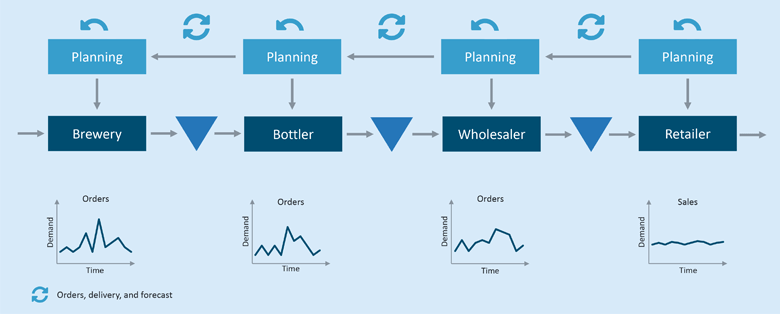The Bullwhip Effect: What Is It and What Causes It?

Let’s start with a question. What is the connection between a bullwhip and a supply chain? It sounds like a joke. After all, what similarities can there be between the cowboys and cattle of the Wild West and the machines and assembly lines of industry? However, they do share something significant. In both worlds, a small action can have a huge effect. When a cowboy swings his bullwhip, a comparatively small arm movement at one end of the whip causes a wide swing at the other end. And the longer the whip, the bigger the swing. Equally, just a small fluctuation in demand at one end of the supply chain can completely disrupt production at its other end. Again, the longer the chain, the stronger the impact. However, while a strong whip is intentional in the Wild West, industry is urgently looking for ways to soften or – ideally – prevent such large swings along its supply chains. To do this, it is important to understand how the bullwhip effect occurs in the first place. SEEBURGER expert Rolf Holicki gets to the bottom of this phenomenon.
In times like the current Covid pandemic, demand in several industries is particularly volatile. While it has always been challenging to interpret demand and make the right decisions from it, in a world where toilet paper can trade like gold from one day to the next, it has become a massive challenge to optimally stock supermarket shelves according to fluctuating demand. Learn about the link between demand fluctuations and the bullwhip effect and its impact on the entire supply chain. In another article, you will learn how to anticipate the bullwhip effect in your supply chain, mitigate it or even prevent it.
What is the bullwhip effect?
The bullwhip effect is also called the Forrester effect. It was first coined in 1961 by Jay Wright Forrester, professor at the MIT Sloan School of Management, in his 1961 book Industrial Dynamics. The bullwhip effect describes a phenomenon that can cause massive disruptions in supply chain management. Even small fluctuations in demand from the end customer can trigger exponentially increasing fluctuations in demand from upstream suppliers. What is interesting is that the longer the supply chain and the further away one is from the customer, the greater the impact of these fluctuations. To stay with the image of the whip-wielding cowboy: The longer the whip, the greater its swing. Professor Forrester and his students enjoyed illustrating this effect with the “Beer Distribution Game”.
Demonstrating the bullwhip effect with beer
Professor Forrester’s Beer Distribution Game explores what happens if an unexpected surge in retail demand for beer (figuratively, the small arm movement in a whip swing) triggers unexpectedly high demand in the brewery (the wide swing). Figure 1 illustrates this bullwhip effect. The very simple supply chain used here consists of:
- brewery,
- bottling plant,
- wholesaler and
- retailer.
 Figure 1: Simple illustration of the bullwhip effect as shown by Professor Forrester’s Beer Distribution Game[1]
Figure 1: Simple illustration of the bullwhip effect as shown by Professor Forrester’s Beer Distribution Game[1]
So let’s assume that an unexpected heat wave causes demand for beer to increase dramatically overnight. Retailers immediately react and increase their orders from wholesalers. However, the retailers order more than they need to take into account delivery time and have some beverages in reserve for later customers. This effect continues through the supply chain: the quantity ordered is higher than the quantity actually needed at every stage of the network. Figure 1 above shows the effects that these varying order quantities have on the individual supplier. While the retail fluctuations are still relatively small, the brewery’s chart shows much larger swings in orders. That is the bullwhip effect.
What triggers a bullwhip effect?
Figure 1 illustrates that even in a relatively small four-tier supply chain, changes in orders can have an enormous effect on downstream suppliers. Within multi-tier supply chains with demand patterns that are difficult to predict, ordering behaviour is influenced by many different factors. Key reasons for inventory fluctuations include lack of coordination or insufficient demand, order and logistics information. Let’s take a closer look at some of these.
- Delivery speed – the time between placing and receiving an order
Order lead time can vary greatly depending on the product and its position within the supply chain. It could be affected by an uncertain supply of raw materials, or by a long production period for components. Long lead times tend to cause larger orders downstream. In this way, retailers and others can ensure that they have enough product in stock to react quickly to fluctuations in demand… - (Non-)availability of information on supply chain
There are many reasons why you may have inaccurate or delayed information on the availability of raw materials or components. Global supply chains are fragile, and can be affected by events as diverse as political instability, natural disasters, global pandemics (a very topical issue) or even shipping issues like the container ship Ever Given recently getting stuck and blocking the Suez Canal. These make it next to impossible to predict when products will become available and the supply chain will start flowing again. - Overreaction to misinterpreting availability – panic buying
The – ahem – ‘run’ on toilet paper shortly after the outbreak of Covid in March 2020 still amazes us. The Süddeutsche Zeitung devoted an article to this phenomenon, concluding that a shortage is created less by an actual, immediate threat than by the fear of it. It is this phenomenon that explains the panic ordering in the beer distribution game example above. Misinterpreting demand, overreacting and hoarding behaviour can quickly lead to fluctuations in the supply chain. - Length and number of steps in a supply chain
The more complex a supply chain, the more even small fluctuations in order quantity at the beginning of a supply chain can increase as they flow upstream. Using a simplified four-tier supply chain, Forrester found order increases of 900%. As the number of participants in the chain increase, so do the fluctuations. - Economic measures such as price politics or order bundling
It is a fundamental principle of market economics: demand determines the price. This in turn has a direct influence on ordering behaviour. If products or raw materials are subject to high price fluctuations, this influences when and how actors downstream place orders. If a client suspects a price increase in the near future, they will order more to benefit from current lower prices. Or, they will bundle orders to benefit from a quantity discount or save on shipping costs, for example. This behaviour only leads to an increase in stock, not actual demand. However, this triggers a chain reaction that continues to the last link in the supply chain.
Just these simple examples show how decisions based on insufficient information, misinterpretation or a lack of communication can trigger the bullwhip effect. In the second part of this series we will look at how to mitigate or even prevent the bullwhip effect. As you have probably already guessed, digitalisation, automation and networking measures play a significant role in this. Stay tuned!
[1] Based on: The bullwhip effect – Beer Distribution Game – Kearney (accessed 19th Nov. 2021).
Source: https://blog.seeburger.com/the-bullwhip-effect-what-is-it-and-what-causes-it/
 industry-trend6.com
industry-trend6.com
